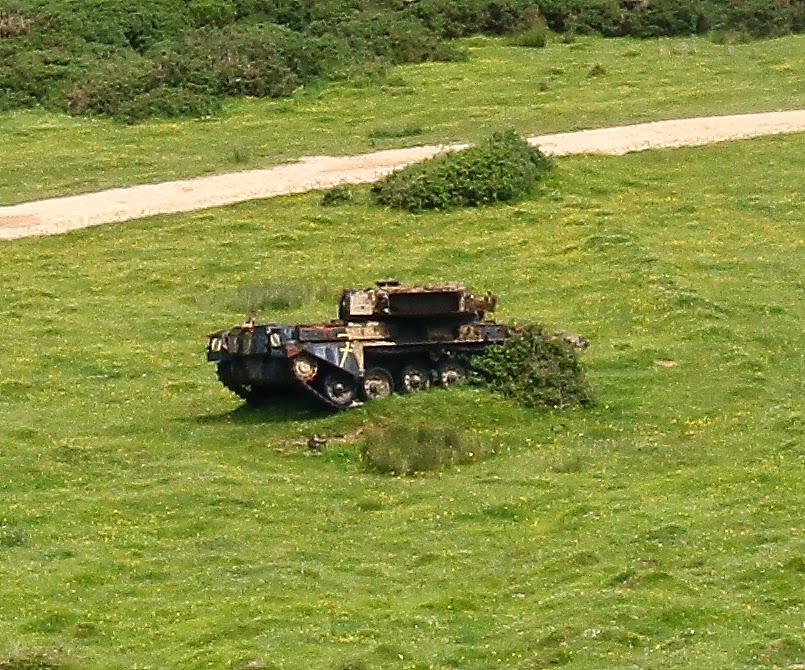The forecast is not looking hopeful for the weekend, so I decided to get out today with the camera in the breezy & intermittently sunny conditions. I had only got as far as the car, when I saw the first thing of interest. It was a Hercules flying low over Nine Barrow Down towards Studland. Presume it's tied in with the D-Day 70th celebrations as Studland Bay was used for some of the live firing rehearsals.Today is the 70th anniversary of Normandy landings.
Hercules: Flying low over Nine Barrow Down towards Studland. Low flying Hercules are fairly regularly seen locally, but that's something for a future posting
There have been no follow on sightings of the Short-toed Eagle up to when I left the house, so I decided that I would have a look around the Lulworth Ranges as that was the last direction it was seen flying in when it left Morden Bog. I didn't expect to relocate it, but it was a good excuse to have a look around the area. There is a public road from East Lulworth to Kimmeridge which provides excellent views of the Lulworth Ranges, however, part of this road is often closed as the Lulworth Ranges & the coastline to the South are part of a military training ground. But I figured it would be open as there wouldn't be any training on the 70th anniversary of D-Day. Parking up in a layby gave me a great view over the tank training grounds.
Looking over the Lulworth Ranges: There is some great looking heathland in the distance, but no sign of any Eagles (much to the relief of the local Snake population)
Old tanks never die: A few lucky ones end up at the nearby Bovington Tank Museum, the best Tank Museum in the world, but many end their days here
Another tank skulking in the bushes
Looking West is Lulworth Castle: Not a real Castle, just a early 17th Century Hunting Lodge & Stately Home. I guess it hasn't got any dungeons
Corfe Castle: Now this is what I call a proper Castle & I'm sure it has some real dungeons (Nov 13)
Corfe Castle: Now this is what I call a proper Castle & I'm sure it has some real dungeons (Nov 13)
Looking North East is Poole Harbour: This is the Wareham Channel & the Arne Peninsula to the right
Sika Deer
Sika Deer
Sika Deer
Sika Deer: I had suspected these might have been Fallow Deers, but thanks to Richard Webb who confirmed they were Sikas
Next stop was Holmebridge in the Lower Frome Valley to look for Dragonflies. This is a great area of water meadows with access via a public footpath, but I quickly realised it was also a great day for grass pollen & I quickly started suffering from a bad hay fever attack. I persisted for a couple of hours, before finally having to give it up. But there was a good selection of Dragonflies & Damselflies on view.Sika Deer
Sika Deer
Sika Deer: I had suspected these might have been Fallow Deers, but thanks to Richard Webb who confirmed they were Sikas
Small Tortoiseshell
Peacock Caterpillars: I don't find caterpillar identification easy, so let me know via the Comments if I've got this wrong
Peacock Caterpillars: I don't find caterpillar identification easy, so let me know via the Comments if I've got this wrong
Golden-ringed Dragonfly: Female. The female has slightly different gold rings to the male & a long pointed ovipositor
Broad-bodied Chaser: Female. The broad abdomen & dark bases to all 4 wings makes this an easy Chaser to identify
Banded Demoiselle: Male with the strikingly easy to identify banded wings. There were a few here, but generally pretty mobile
Azure Damselfly
Azure Damselfly: Mating pair
Common Blue Damselfly: The shape on the second segment looks like a head & neck sticking out from the black base line (Stocker's Lake, Herts, June 2012)
Southern Damselfly: The shape on the second segment is an the most complicated. I think of it as a Viking with the big horned helmet and standing with legs together (Dorset, July 2012)
Chrysotoxum bicinctum: A good looking Hoverfly
Azure Damselfly: Mating pair
I find identifying the small blue Damselflies difficult as you need to look for the shape of the black markings on the second segment of the abdomen (counting from the head end) & that means getting a reasonably good view. Then there is the really tricky bit of being able to remember which markings belong to which species. In Dorset, we have to worry about 3 species: Azure, Common Blue and Southern. There is a possibility of Variable also occurring, as they are found in neighbouring Wiltshire & Hampshire, but currently the previous historical records have been rejected.
Azure Damselfly: The shape on the second segment is an U shapeCommon Blue Damselfly: The shape on the second segment looks like a head & neck sticking out from the black base line (Stocker's Lake, Herts, June 2012)
Southern Damselfly: The shape on the second segment is an the most complicated. I think of it as a Viking with the big horned helmet and standing with legs together (Dorset, July 2012)
Chrysotoxum bicinctum: A good looking Hoverfly
I returned home to find one of my local Bullfinches pairs has had the first fledged juvenile. I get frequent daily visits from at least 2 pairs of Bullfinches (bribery with black Sunflower seed really works with them). I always happy when I see this cracking bird as they are one of my favourite UK Birds. Although they are happy to feed at the feeders within a metre of the kitchen door, they won't come in if the kitchen door is open. So I ended up having to photograph through the window.

























